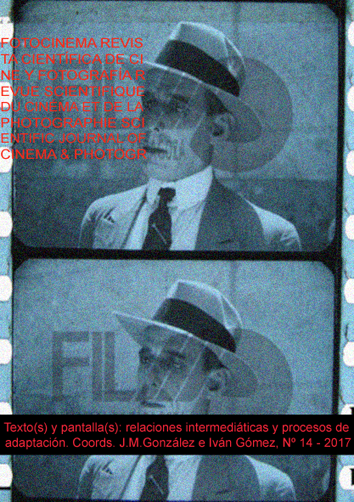Adaptando el terror cinematográfico a la serialidad televisiva. El caso de Scream
DOI:
https://doi.org/10.24310/Fotocinema.2017.v0i14.3598Palabras clave:
adaptación, televisión, cine, terror, Scream, Adaptation, Cinema, HorrorResumen
Durante el nuevo milenio ha aumentado significativamente la producción de series televisivas en el ámbito estadounidense. En este contexto, el reciclaje de ideas, los remakes y las adaptaciones se han convertido en una práctica habitual en un mercado que necesita abastecerse constantemente. Entre otros medios, el cine se ha propuesto como una fuente argumental recurrente para la industria televisiva, generándose numerosas adaptaciones seriales a partir de una película. Asimismo, el mercado televisivo está marcado por la fragmentación de las audiencias y la necesidad de especialización temática, lo que favorece el traslado de todo tipo de géneros; concretamente, en los últimos años el género de terror ha generado varias adaptaciones televisivas a partir de clásicos cinematográficos. El presente artículo analiza cómo la serie Scream adapta la famosa saga cinematográfica de la que procede. El objetivo es comparar los principales cambios que se producen entre serie y película, observando las dificultades de trasladar un subgénero tan complejo como el neo slasher.
Descargas
Métricas
Citas
Altman, R. (2000). Los géneros cinematográficos. Barcelona: Paidós.
Balló, J. y Pérez, X.(2005). Yo ya he estado aquí: ficciones de la repetición. Barcelona: Anagrama.
Benchichá López, N. Y. (2015). La tercera edad dorada de la televisión. Battlestar Galactica y las nuevas formas de pensar, hacer y consumir el drama televisivo norteamericano. Tesis Doctoral. España, Departamento de Comunicación, Universitat Ramon Llull.
Carroll, N. (1990). The Philosophy of Horror or Paradoxes of the Heart. New York: Routledge.
Clover, C. J. (1987). Her Body, Himself: Gender in the Slasher Film. Representations, No. 20, Special Issue: Misogyny, Misandry, and Misanthropy. (Autumn), 187-228.
Díaz, S. (2012). Adaptación audiovisual e hibridación discursiva. La serie Wallander como paradigma. Revista Comunicación, Nº10, Vol.1, 504-516.http://www.revistacomunicacion.org/pdf/n10/mesa3/039.Adaptacion_audiovisual_e_hibridacion_discursiva.Las_series_Wallander_como_paradigma.pdf
García, P.J. y Raya Bravo, I. (2015). Antes del psicópata televisivo. Siguiendo la pista al asesino en serie en la historia del cine. Asesinos en serie(s). Representación persuasiva del serial killer en la ficción televisiva contemporánea. Madrid: Síntesis, 17-48.
Gordillo, I. (2009) La hipertelevisión: géneros y formatos. Ecuador: Ciespal.
Greimas, A. J. (1987). Semántica estructural. Investigación metodológica. Madrid: Gredos.
Jenkins, H. (2007). The WOW Climax. Tracing the Emotional Impact of Popular Culture. New York: New York University Press.
Leeder, M. (2009). Forget Peter Vincent: Nostalgia, Self-Reflexivility, and the Genre Past in Fright Night. JPF&T (Journal of Popular Film and Television), Vol, 36, Issue 4, 191-199.
http://www.tandfonline.com/doi/abs/10.3200/JPFT.36.4.190-199
Longworth, J. L. (2002). TV creators: Conversations with America´s Top Producers of Television Drama, Volumen 2. Syracuse: University of Syracuse Press.
López Rodríguez, F.J. (2012). Modificaciones narrativas en la adaptación cinematográfica del cómic japonés. Revista Comunicación, Nº10, Vol.1, 1549-1564.
Mittell, J. (2004). Genre and Television. From Cop Shows to Cartoons in American Culture. New York: Routledge.
Murphy, S. (2015). Scream producers explain why the original ghostface mask had to go. http://www.mtv.com/news/2180259/scream-tv-mask/
Ribés Alegría, M. (2005). La hibridación de géneros y la crisis de la calidad televisiva: consejos audiovisuales en el panorama televisivo. Comunicar: Revista científica iberoamericana de comunicación y educación, V. 25. http://www.revistacomunicar.com/verpdf.php?numero=25&articulo=25-2005-131
Rincon, O. (2013). Los formatos audiovisuales de la identidad. En Guarinos, V. y A. Sedeño (eds.), Narrativas audiovisuales digitales. Convergencia de medios, multiculturalidad y transmedia (pp. 165-192). Madrid: Fragua.
Sánchez Noriega, J. L. (2003). Historia del cine. Teoría y géneros cinematográficos, fotografía y televisión. Madrid: Alianza Editorial.
Scolari, C. A., Jiménez, M. y Guerrero, M. (2012). Narrativas transmediáticas en España: cuatro ficciones en busca de un destino cross-media en Comunicación y Sociedad, Vol.XXV, nº1, 137-163. https://dialnet.unirioja.es/servlet/articulo?codigo=3954671
Scolari, C. (2013). Narrativas transmedia. Cuando todos los medios cuentan. Barcelona: Deusto.
Stam, R. (2001). Teorías del cine. Barcelona: Paidós.
Todorov, T. (2005). Introducción a la literatura fantástica. México: Ediciones Coyoacán.
Tous, A. (2009). Paleotelevisión, neotelevisión y metatelevisión en las series dramáticas estadounidenses. Comunicar, Nº33, V. XVII, 175-183. http://www.revistacomunicar.com/index.php?contenido=detalles&numero=33&articulo=33-2009-21
Tous, A. (2010) La era del drama en televisión. Perdidos, CSI: Las Vegas, El ala oeste de la Casa Blanca, Mujeres Desesperadas y House. Barcelona: Editorial UOC.
Verevis, C. (2006). Film Remakes. Edinburgh: Edinburgh University Press.
Wagner, G. (1975). The Novel and the Cinema. London: Tantivy Press.
Wee, V. (2006). Resurrecting and Updating the Teen Slasher: The Case
of Scream. Journal of Popular Film and Television, 34:2, 50-61.
Welsh, A. (2009). Sex and Violence in Slasher Horror Film: A Content Analisys of Gender Differences in the Despiction of Violence. Journal of Criminal Justice and Popular Culture, 16. http://www.albany.edu/scj/jcjpc/vol16is1/Welsh.pdf
Publicado
Cómo citar
Número
Sección
Licencia
Todos los contenidos publicados en Fotocinema. Revista científica de cine y fotografía están sujetos a la licencia Creative Commons Reconocimento-NoComercia-Compartirigual 4.0 cuyo texto completo puede consultar en <http://creativecommons.org/licenses/by-nc-sa/4.0>
Se pueden copiar, usar, difundir, transmitir y exponer públicamente, siempre que:
- Se cite la autoría y la fuente original de su publicación (revista, editorial y URL de la obra).
- No se usen para fines comerciales.
- Se mencione la existencia y especificaciones de esta licencia de uso.
Los derechos de autor son de dos clases: morales y patrimoniales. Los derechos morales son prerrogativas perpetuas, irrenunciables, intransferibles, inalienables, inembargables e imprescriptibles. De acuerdo con la legislación de derechos de autor, Fotocinema. Revista científica de cine y fotografía reconoce y respeta el derecho moral de los autores/as, así como la titularidad del derecho patrimonial, el cual será cedido a la Universidad de Málaga para su difusión en acceso abierto. Los derechos patrimoniales, se refieren a los beneficios que se obtienen por el uso o divulgación de las obras. Fotocinema. Revista científica de cine y fotografía se publica en open access y queda autorizada en exclusiva para realizar u autorizar por cualquier medio el uso, distribución, divulgación, reproducción, adaptación, traducción o transformación de la obra.
Es responsabilidad de los autores/as obtener los permisos necesarios de las imágenes que están sujetas a derechos de autor.














13.png)



